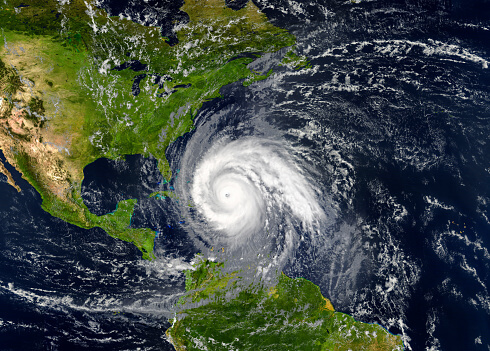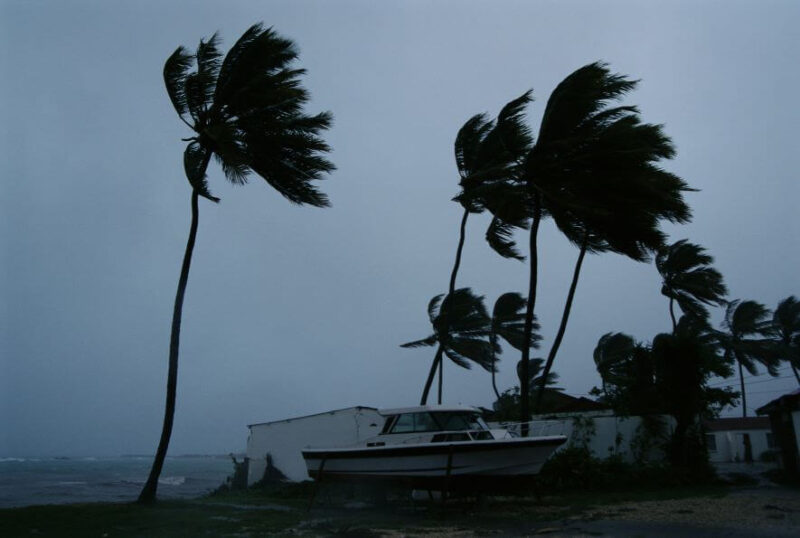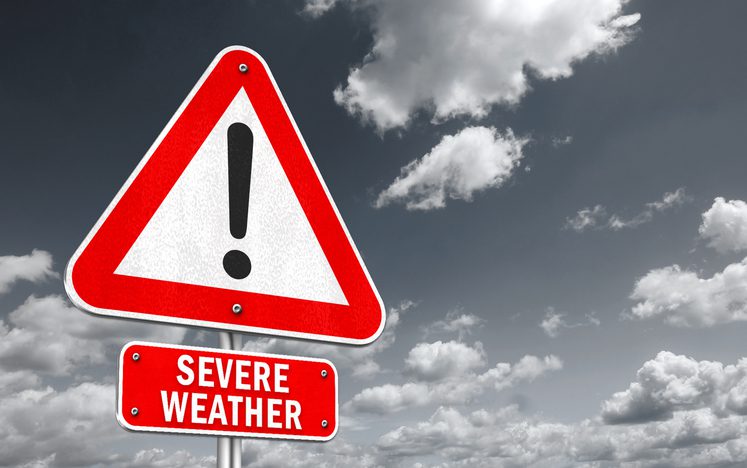If you live in a hurricane zone, making the right preparations is important. The key to staying safe is knowing what to do before, during and after a hurricane to protect yourself, your family and your property. Remember, even a Category 1 hurricane can cause major damage to your home and property.
How Hurricanes Form
When warm, moist air circulating over warm ocean water rises and begins to spiral, it produces a tropical cyclone or tropical depression. This is an area of heavy rain and thunderstorms where winds can reach up to 38 miles per hour.
When the wind speed increases to 39 to 73 miles per hour, the storm is classified as a tropical storm. A storm becomes a Category 1 hurricane (defined by the Saffir-Simpson Hurricane Categories scale) when winds continue at 74 miles per hour or higher. As the speed of the wind circulation within the storm increases, so does the hurricane’s category. It’s category is an indicator of the storm’s damage potential.
The amount of rain that falls is not related to the hurricane’s category, but rather the size of the storm and how quickly it moves across an area. A storm’s direction and traveling speed are steered by the prevailing weather patterns that surround the hurricane. This is different then the speed of the wind circulation within the hurricane itself. Slower-moving, larger storms can drop more rain on an area, causing severe flooding.
How Hurricanes Move
A full-fledged hurricane is characterized by an internal wind speed of at least 74 miles per hour and a spinning structure in which the wind rotates around the center of the storm–called the “eye” of the hurricane.
The strongest wind and heaviest rain occur in the area around the eye of the storm, called the eyewall. As the hurricane moves, the eye wall will give way to the eye and the wind will calm. The rain will also lessen or subside and the sun may even be visible. However, this doesn’t mean that the storm is over.
As tempting as it may be, you should not leave your place of shelter until you receive word from the weather station that the storm is over. This is because once the eye passes, the wind and rain will pick up again as the dangerous backend of the storm passes over your area.
Although Hurricanes generally move west, they can also move north, northeast and northwest. They are often unpredictable and you may notice that several different storm paths are forecast before a hurricane actually makes landfall. This is because many factors can change the course of a hurricane or cause it to strengthen or weaken.
In fact, in 2005, Hurricane Katrina made landfall on the southeast coast of Florida as a Category 1 hurricane. From there, it continued to travel slightly south before heading west across the peninsula and moving into the warm waters of the Gulf of Mexico. It traveled north for several days, gathering size and power, finally pummeling into the Louisiana coastline as a large Category 3 Hurricane. Its winds reached 125 miles per hour.
When and Where Hurricanes Strike
Hurricane season runs from June 1st to November 30th, peaking from mid-August to late October. During that time, an average of six hurricanes will form in the Atlantic Ocean, Caribbean Sea or Gulf of Mexico and two hurricanes will form in the Central Pacific Ocean. During a typical 2-year period, an average of three hurricanes will make landfall along the U.S. coastline and one of them will be a Category 3 or higher.
The most hurricane-prone coastlines include:
- North Carolina
- Central to South Florida
- Northwest Florida
- Mississippi
- Louisiana
- North East Texas

5 Ways to Prepare for a Hurricane
In addition to the wind damage and rain, if you live on the coast, the storm surge (a rise in the wave level due to the increased winds) can pose the greatest threat to your life and your property.
Here’s how to prepare for a hurricane before the season starts:
1
Create an Evacuation Plan
If you live in a hurricane evacuation zone, put together a written plan detailing where you and your family will evacuate. Plan how you’ll get there should an evacuation order be issued. Select a location outside of the evacuation zone like a family member’s home or a public shelter. Be sure to consider your pets when developing your plan. Most local shelters do not allow pets.
2
Put Together a Hurricane Kit
You’re going to need supplies to get through the storm and its possibly lengthy aftermath. Stockpile enough water, non-perishable food (and a can opener) and medicine to last everyone in your household (including your pets) for at least one week. You’ll also need:
- Clothing
- Blankets
- Flashlights
- Batteries
- A hand-crank radio
- Extra tarps and plywood for securing any damaged areas of your home
Get a corded phone, as the phone jacks may still work even if the electricity and cell towers go down. You may want to purchase a crank- or solar-powered USB charger for your cell phone. You could even invest in a small or whole-house generator. Store important documents in a large, waterproof envelope and include:
- Social security cards
- Licenses
- Insurance policies
- Property photos
- Emergency numbers
- Repair numbers
3
Strengthen Your Home
Make sure your home is in good repair and up to local hurricane building code specifications well before hurricane season begins. Many pre-hurricane safety projects don’t cost as much or take as long as you might think. Before hurricane season starts, purchase the appropriate plywood, steel or aluminum panels for protecting your windows and doors. And check that your garage door is up to code. If necessary, have the support bracing retro-fitted as the garage can be a weak spot for wind.
4
Review Your Insurance Policies
Call your insurance agent or company to check whether you have enough homeowners insurance to repair and even replace your home’s structures and contents in the event of hurricane damage. If you are in a flood zone, you’ll need a separate flood insurance policy. Standard homeowners insurance doesn’t cover weather-related flooding. Plan ahead because there’s a 30-day waiting period before your flood policy will take effect. Review your car insurance and boat insurance policies as well.
5
Take Pictures of Your Property
Photograph all four sides of your home’s exterior, as well as any other structures covered by your home insurance policy, like:
- Outdoor buildings
- Decks
- Fencing
- Pergolas
They will be extremely helpful if you have to file an insurance claim for hurricane damage. Print the photos and store them in a safe, waterproof location. Be sure to save copies online as well.
How to Stay Safe During a Hurricane
When a hurricane has been forecast, cover your windows with plywood or shutters. Move or secure anything movable in your yard, like:
- Lawn furniture
- Potted plants
- Grills
- Lawn ornaments and decorations
Just before the winds and rain pick up, turn your refrigerator and freezer to their coldest settings. Keep them closed to hold in the cold in case you lose power later. Lock all doors and windows once everyone (including pets) is inside. Be sure to stay inside until you receive the official all-clear. Even if you think the storm has subsided, it may just be the eye passing over.
As much as you might want to watch the storm once the wind and rain begin to blow, stay away from your windows to avoid injury from flying debris and broken glass. Hunker down in a room with no windows (or the least windows). Try to take shelter on the lowest floor of your home in case the roof is breached by trees, flying debris, wind or heavy rain during the hurricane.
Check your local weather service using your battery-powered radio or device every 30 minutes to keep up with the status of the storm. Keep an eye out for any emergency notifications that have been issued.
What to Do After a Hurricane Has Passed
The Department of Homeland Security website warns to stay clear of debris and especially downed power lines. Don’t walk or drive through flood waters. Just six inches of moving water can knock you down and ,if the water is fast-moving, it can sweep you and even your vehicle away. Furthermore, flood waters can obscure all types of dangerous debris or sink holes. They can also be electrically charged by underground or fallen power lines.
Once you receive the official all-clear and it is safe to go outside, inspect your property. Photograph any damage and call your insurance company to file an insurance claim as soon as possible if necessary.
Be sure to do everything you can to prevent further damage to your property (in case of another storm). For example, secure a breached roof with a tarp or other approved covering. If you don’t, any further damage to your roof or personal property may not be covered by your insurance policy.
Conclusion
Remember, hurricanes are incredibly destructive and have the potential to cause a catastrophic loss of life. Begin preparing well in advance to help ensure the safety of you and your loved ones.







